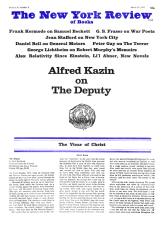The “superior” or “OK” comic strip, aimed at an audience that might include readers of books also, cannot be very ancient. While I was growing up, there always seemed to be at least one around. (I don’t mean to include Mutt and Jeff, by the way, enshrined among the allusions in Finnegans Wake.) I always think of them as occurring in sequence, although they undoubtedly overlapped for years; at different times in my life one or another would seem worth reading. Thus, the starkly lyrical Krazy Kat appeared in the Sunday comics during my child-hood (Herriman’s strip might be said to be the first of the “OK” series), but it was not until I had been thoroughly corrupted by a sense of history and, alas, by an appreciation of archetypal paradigms, that I realized that Krazy was authentic and visionary. But the rest of the series follows historical periods clearly enough. There was Barnaby during my popular-front high school days; Crockett Johnson’s hard-edge, watered-down Crock of Gold seems so inseparable now from the very format of PM that I wonder how it ever outlasted its original showcase.
Then, suddenly, Pogo was upon us and, after the inevitable too much of a good thing, I seem to remember people’s interest shifting away from the static strip to the first unquestionably original graphic techniques of the early UPA animated cartoons. But when the sophisticated abstraction, parody of animation and dubbing, and casual plots of the UPA group were taken over by the producers of the same old tedious and appallingly silly cat-flatteners, suddenly there was Peanuts to be pointed out to one by some technological, non-literary friend. And so it will no doubt continue.
It must be said, though, that all the time this was going on, there was Li’l Abner for those who cared. It outlasted so many of the other advanced strips because its particular virtues never seemed tied to the pace of any one decade. Krazy Kat’s Beckett-like reduction of reality to a few stage props may seem modish today, but the spirit of the strip is still that of pre-depression, marginal city life. Barnaby, for all its rather Parisian de-mythologizing of myth, was really, after all, in the words of PM’s immortal manifesto (have you forgotten it?) “against people who push other people around.” Pogo’s forte was primarily for language, and its dense and detailed pictorial space always seemed to me to support rather than outshine it. But then again, after all, Pogo was the anti-McCarthyite comic strip, and after it seemed obvious that Adlai Stevenson would never get to be President, its whole world seemed somehow less relevant. And so on. The elegant seriousness of the children in Peanuts, the whole collection of middle-class characterological prototypes, still beautiful because still unwrecked by suburbia, may withstand reality for a little while longer.
But this, too, shall pass. Only Li’l Abner would seem to be with us always. Its origins in an urban, New Deal view of all of America, are quite obvious and, as Reuel Denney put it in The Astonished Muse, “The strip has never lost its hurt, serious tone of concern with inequality of social opportunity.” The complicated pastoral reversals through which an Erskine Caldwell world was twisted could, from the beginning, extend beyond the resonances of the depression, and TVA. Even more important, perhaps, was the general power of the strip’s extremely sophisticated attitude toward visual stereotypes: the inhabitants of Dogpatch are caricatures of caricatures, and the hillbillies, city-slickers and Slobbovians all seem drawn to represent the way each looks to the other. And then of course there is always the question of the role of Daisy Mae in the background of the Marilyn Monroe façon.
In any event, Al Capp’s drawing has continued, undaunted, for thirty years. Its view of the world is no longer adequate, and it really doesn’t seem to be very funny on occasional reading. But it should be allowed to continue, and certainly without the gross disservice done it by Beacon Press, in collaboration with David Manning White and Mr. Capp himself. The disservice is embodied in about 120 pages (often there are only two frames on a page) of selected and revised Li’l Abner episodes from 1949 to the present. They are not particularly good ones (the only section of barely minor interest was a self-conscious and harrumphing flash-back to the founding of Sadie Hawkins Day—surely, with the Schmoo, Mr. Capp’s most well-known and unnecessary invention). Moreover, they are accompanied by vulgar and pretentious moralizings by Mr. Capp which are far below even the undistinguished level-of the chosen strips. Even where the sentiments are unexceptionable, they are rather pitiful, and in one case at least, had better not have been uttered, viz., “The paleness of the Caucasian must be a revolting sight in the lower-rent districts of Dutch Guinea [sic! whamm! gulp!] where folks are a normal, healthy black.” The whole point about Li’l Abner is that it was conceived and drawn by a man who would never use “folks” in this way, even when talking to children.
Advertisement
It is hard to believe that the Beacon Paperbacks series which has given us Harnack’s Outlines of the History of Dogma and the like could seriously devote itself to as inept a project as this. For whom was it compiled? The concluding remarks of Professor White, who has co-edited books on mass culture and on the comic strip, are of little help, being as banal and badly expressed as Mr. Capp’s commentaries. What one would have liked, I imagine, is an intelligently selected group of selections, from 1934 on, with little comment other than datings and a few topical glosses, perhaps. It’s hardly a tragedy; but it is too bad.
This Issue
March 19, 1964



